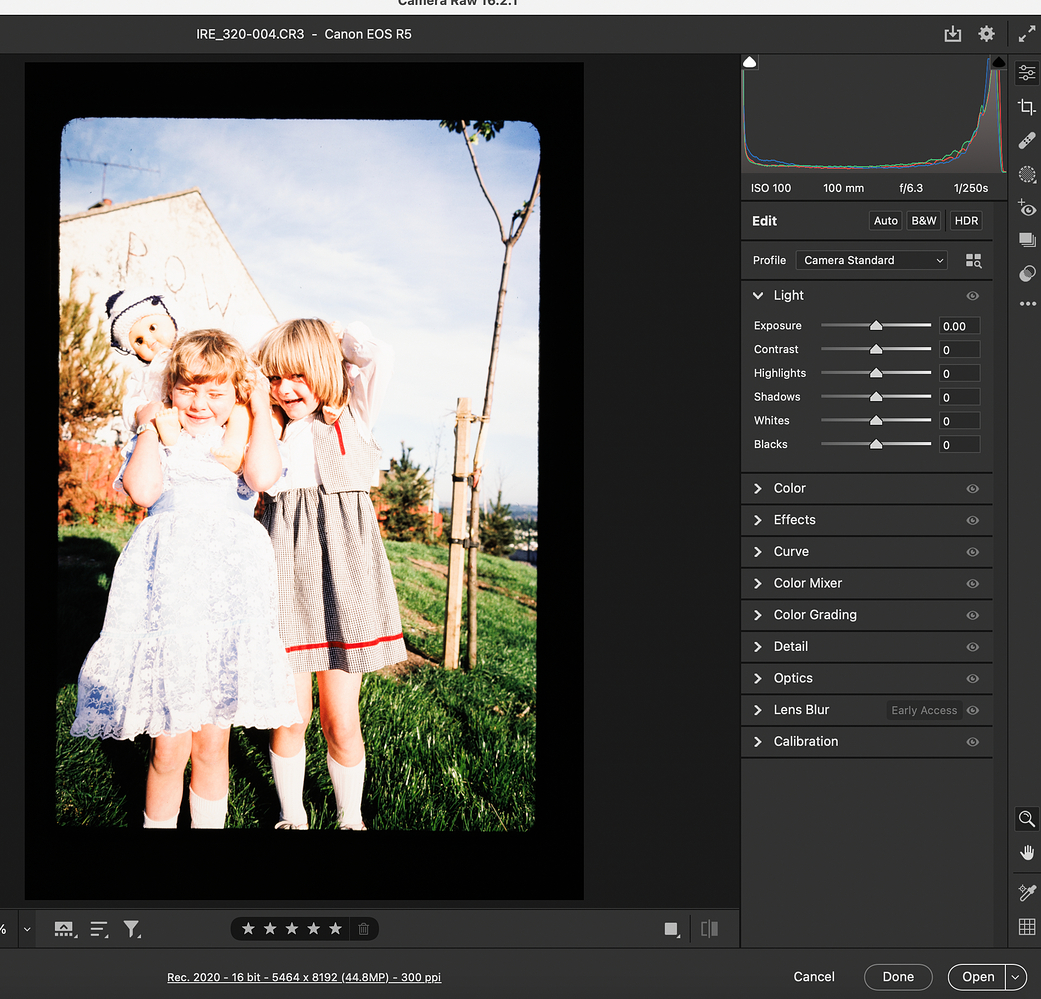After having started this conversation quite awhile ago, I have been away awhile for all kinds of reasons and only sparely catching up. In that time I have scanned 25,000 35mm E6 slides. I have learned a lot and that in in no small part due to y’all early on! Thank you.
Happy to answer any questions about the setup, even on the organizational and metadata end for the archiving process as this is all being given to a research institution. I feel like I have become very skilled at this!
The long and the short of it, for me, has been there is no end to the depths of seeking ever-more perfection as far as color goes. Sharpness, stability, and perfecting the light, as well. So I came up with a 2 tiered system that has worked well for mixed slides from many types of E6 film with no rhyme or reason. I also fiddled with the light source positioning, diffusion, collimation/focusing, etc. and landed in a nice place.
After around 7000 slides through the projector I abandoned center-weighted autoexposure using highlight protection, replacing that with hard shutter limits for a fully fixed exposure on all but the most thick or thin emulsion slides. It has worked wonders for consistency. On the light table I have played with various diffusion solutions
Tier 1- bulk scan with the hacked/modified Kodak Carousel + BoopBoop Trigger/advancer from Camerdactyl + Canon R5 with EF 100 2.8L + SORAA VIVID 3000ºK 7.5W LED bulb diffused and refocused through the original lens but without the IR heat lens. ISO 100, f7.1, 1/250th (protects highlights on all but the thinnest of emulsions). Lens cannot reach 1:1 due to projector design but end up around 1:1.3 and getting a 32MP file after a crop. This provided 300-1000 slides per hour depending on their cleanliness and orientation (all must be dusted, landscape, and emulsion away from camera to limit processing time) after noticing the speed early on create errors and hang ups both human and computer. There is about a 0.1% error rate if I do not rush (around 750 slides/hr).
For most people and most purposes, it is great. The 3 pros I have bulk scanned slides for have been very pleased. Prints well up to 13x19, edits easily, etc. No complaints. Generally speaking the embedded JPEG previews within the raw files still look awful. There is no amount of lowered contrast and camera profile adjustments to get them to look as they do through a loupe. The previews are magenta tinted and higher contrast than desired. That said, the RAW files work great. Control the black point on the curves, 2850ºK usually, set to Adobe Neutral (a custom could be created easily), -50 on contrast, tiny tweaks to highlights, +15 whitepoint, some minor minor tint and color channel saturation tweaks, with some basic sharpening set up on a preset and they look fantastic and accurate, reliably.
For speed, this is an incredible way to do it. I basically made a SlideSnap at home for MUCH LESS. (https://slidesnap.com/). Grand total I spent many (covid year) hours on this, but only about $450-500 compared to $3600+. It has paid for itself many times over.
Tier 2 for selected/culled images- Copy stand, homebrew handmade 97CRI LED 16x12" 4700ºK light table good for up to 8x10. R5 + Sigma ART 70mm 2.8 @ near exactly 1:1 magnification leaving a TINY bit of space to crop for errors and getting a 42MP file. If it not very flat, I can back off to 1:1.1 for a little more DOF. ISO 100, f4.5-7.1ish, 1/125-500th as needed not clipping any highlights. The edits are similar but with adjustments made accounting for the slightly differing light source. 60-150 slides/hr are possible.
This setup is much sharper than with the EF 100mm L and look great, including much better tint in the preview images though intense contrast vs the original. The RAWS are killer. It would only be sharper if I unmounted the selected slides and put them in a better holder but that is a no go for this preservation project.
I hope to switch to the Sigma 105mm ART if it ever comes to RF mount but may try the Laowa 100mm for its ability to go to 2x for half frames/110 but its high rating at 1x similar to the Sigma. I am tempted by some more exotic glass as well though mounted slides are not flat so fixed aperture glass is not really usable. I am also tempted to switch the the Panasonic SR1 for the best multi-shot implementation for larger formats but in the meantime intend to test my friend’s Fuji 100S.
In a few months, we will be more reliably focusing on more consistent emulsion types, rather than mixed up, and I will start to employ some of the color management ideas that have been thrown out along the way here since there may be a bigger budget soon. I want to try using a flash or SOLUX bulbs as well when I get more time. More construction projects!
And lastly, I want a geared copy stand, it would be so much easier than the squeeze-n-slide model I have from Smith Victor.
Thanks again everyone!










